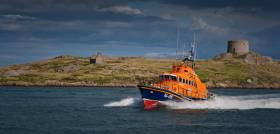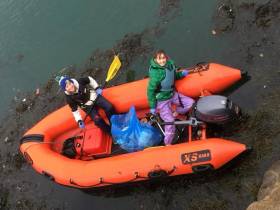Displaying items by tag: Dun Laoghaire
‘Floating Homes’ Plan For Dun Laoghaire Harbour Moves Forward
#Property - Plans to develop “floating homes” in Dun Laoghaire Harbour — and refocus the area on accommodation as well as leisure — have moved a step forward as a formal procurement process is set to begin.
Last September, the Dun Laoghaire Harbour Company sought expressions of interest for plans comprising “a cluster of floating affordable homes” moored in the harbour.
“About two years ago we looked at the notion of a floating hotel,” Dun Laoghaire Harbour Company chief Gerry Dunne told the Sunday Independent. “This concept is the same — to utilise the water space for residential purposes, rather than just leaving it for leisure pursuits.”
The precise specification of the final homes has get to be determined, though a retail price of up to €350,000 is to be expected.
Dunne also expects that if the procurement process is completed in the first quarter of this year, “we could have the floating homes project up and running in 2019.”
The Sunday Independent has more on the story HERE.
Bicentenary Review of the Construction of Dun Laoghaire Harbour
A bicentenary review of the Construction of Dun Laoghaire Harbour by author and historic building consultant Rob Goodbody will be held on the 1st February at the DMYC club house on the West Pier in Dun Laoghaire.
'Even though it is treated as an engineering subject, it will be of genuine interest to the lay person, as much for the reasoning and motivation for the harbour’s construction, according to lecture convenor and DMYC sailor Cormac Bradley.
The first stone for the large harbour at Dunlaoghaire was laid in May 1817 and in 2017 a number of events to commemorate this bicentenary took place, including a visit by the President, Michael D Higgins.
This presentation introduces the background to the building of the harbour before examining how the harbour was constructed and how works progressed to the completion of the piers more than a quarter of a century later.
Rob Goodbody is a historic building consultant. He has researched the history of Dun Laoghaire harbour over many years and this summer past was conducting guided walks to commemorate the bicentenary of the harbour.
He has written several books including The Metals - from Dalkey to Dunlaoghaire and has co-authored a number of others, most recently Dublin Bay - Nature and History, which has been published by The Collins Press.
#DLHarbour - Dun Laoghaire Harbour Company has issued its first notices to mariners for 2018, superseding all previous marine notices.
Regarding fairway priorities, the harbour fairways and approaches are generally to be kept clear and free. It is prohibited to anchor or lay moorings in these areas as marked on navigational publications and charts.
No race marks, buoys, floats, etc are to be laid in the fairways or the near approaches to Dun Laoghaire Harbour – and no racing shall take place other than by specific written permission from the Harbour Master.
Any lobster/crab pots that are laid shall remain clear of all harbour navigational waters, and slipways.
Large power-driven vessels (cruise liners, ferries, lighthouse and Naval Service vessels) and smaller power-driven vessels with restricted manoeuvrability (such as cruise ship tenders and small passenger ferries) have priority over all other craft, including the area of the harbour limits that extend 600 metres seaward of the harbour mouth.
Large power-driven vessels are to sound a prolonged blast when approaching the harbour mouth from either direction, or the appropriate signal when manoeuvring off, departing or preparing to depart from their berths.
A vessel may also sound a preliminary, prolonged blast, just prior to departure, so as to alert other harbour users of its imminent departure.
Irrespective as to whether or not any such signal is sounded, the obligation remains for small craft togive priority to the large power-driven vessels.
Regarding VHF reporting, all vessels, excluding pleasure craft, are required to call ‘Harbour Office Dun Laoghaire’ on VHF Channel 14 as follows:
- ETA at harbour entrance at least two hours in advance, and for any scheduled ferries call at least half an hour in advance.
- ETD at least one hour in advance, followed by confirmation five minutes prior to departure.
Unscheduled arrivals should call ‘Harbour Office Dun Laoghaire’ on mobile +353 83 144 3412 (24hr) at least two hours before arrival.
Planning Permission Sought For Bus Depot In Dun Laoghaire Harbour
#DunLaoghaire - Planning permission is being sought to park as many as 20 buses overnight for up to seven years at the former Stena HSS vehicle compound in Dun Laoghaire Harbour.
Details of the application on Dun Laoghaire Rathdown County Council’s planning website indicate that a change of use is also sought to employ the existing freight ticket office as staff facilities for Go-Ahead Transport Services, with no alterations proposed.
Observations can be made on this application up until Monday 5 February.
Dun Laoghaire RNLI Will Remember Irish Lives Lost In 2017 At Annual Christmas Eve Ceremony
#RNLI - The volunteer crew at Dun Laoghaire RNLI will hold their traditional Christmas Eve ceremony to remember the 15 volunteers that died on service in 1895 at noon this Sunday.
The crew will remember all those who lost their lives around the coast and inland, and this year will be paying a special tribute to their Irish Coast Guard colleagues, the crew of Rescue 116, who died tragically last March.
Taking place at the lighthouse end of Dun Laoghaire’s East Pier, the short ceremony will include music, an ecumenical blessing, a contemporary newspaper account of the 1895 tragedy and a piped lament.
Both the all-weather and inshore lifeboats stationed at Dun Laoghaire will launch and the crew will lay wreaths at sea close to the pier.
The ceremony is a long-standing Christmas Eve tradition that remembers the lives of the 15 volunteer crew that died when their lifeboat capsized in gale force winds while attempting to rescue those on board the SS Palme that had run aground off Blackrock, Co Dublin.
All lives lost around the Irish coast and on inland waterways in 2017 will be remembered during the ceremony.
How One Girl Is Leading The Fight Against Litter In Dublin Bay
#DublinBay - Litter in the water is a longstanding issue in Dun Laoghaire and Sandycove — but one local schoolgirl has taken it upon herself to do something about it.
Ten-year-old Flossie Donnelly started this past summer calling for volunteers to help clean up the sea shore at Sandycove every Friday evening, even designing her own poster to spread the word on social media and around the neighbourhood.
On her blog, Flossie writes that she was “really sad” that no one came to her first clean-up.
But a meeting at the Forty Foot the next day with county councillor Cormac Devlin led to the word spreading further in the local press.
“It’s very unusual that a child of her age approached an adult and a politician at that. That she is so environmentally aware is wonderful,” Cllr Devlin told the Dublin People in August.
By the end of the summer, Flossie was in charge of her own crew of volunteers helping to remove plastic debris that is dangerous to Dublin Bay’s marine life and local boaters alike.
Despite the shorter days and colder weather of late autumn and winter, Flossie is still leading regular coastal clean-ups and making friends along the way — including an Australian girl whose message she found in a bottle.
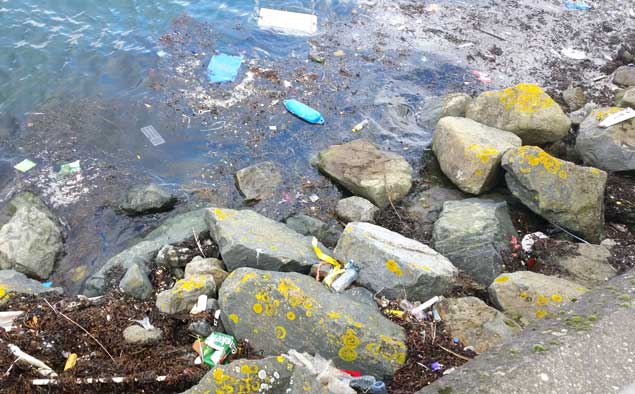 Marine debris in Dun Laoghaire
Marine debris in Dun Laoghaire
More recently, Flossie was out on a RIB in Dun Laoghaire Harbour to clean up the breakwaters — filling three boats with rubbish and doing “a week’s work in a day”, according to Dun Laoghaire Coast Guard, who praised the “inspirational” girl for her efforts.
But the ambitious youngster isn’t stopping there, with plans to raise money for the installation of a Seabin automated cleaning system for the harbour, in what would be a first for Ireland.
Previously highlighted during Afloat.ie’s Rio Olympics coverage last year, the Seabin device has the potential to collect as many as 83,000 plastic bags or 20,000 plastic bottles each year.
That amounts to half a tonne of plastic annually, from visible debris to micro-plastics that threaten our protected species.
Britain’s first Seabin was recently installed at the pontoon of America’s Cup team Land Rover BAR in Portsmouth as part of a project to restore populations of oysters in the Solent.
Flossie and her beach cleaning squad will be hosting a table quiz at Fitzgerald’s Pub in Sandycove next Thursday 30 November to raise funds towards Dublin Bay’s first Seabin. For details see Flossie’s website HERE.
Dun Laoghaire RNLI Lifeboat Rescues Two Cut–off by Tide at Sandymount
Two people cut-off by the rising tide at Sandymount were rescued by the RNLI Inshore lifeboat from Dun Laoghaire this evening.
The alarm was raised at 4.30pm when the two people found themselves surrounded by water with two more hours of incoming water and nightfall due.
A shore unit of the Irish Coast Guard from Dun Laoghaire spotted the pair from the road and directed the RNLI ILB that launched at 4.45pm and was on scene ten minutes later. However, the depth of water was insufficient to permit the boat to reach the casualties and a crew-member walked the remaining distance to reach the two people who were standing on a sandbank.
They were then brought to the safety of the lifeboat before a decision was made to land them at the Pigeon House Road beach at Ringsend. The pair were unharmed apart from wet clothes and they were then looked after by the Coast Guard personnel ashore.
The operation took just over 90 minutes from start to finish and the lifeboat and crew have returned to station. The Irish Coast Guard rescue helicopter R116 based at Dublin Airport was also tasked but stood-down when the casualties were located.
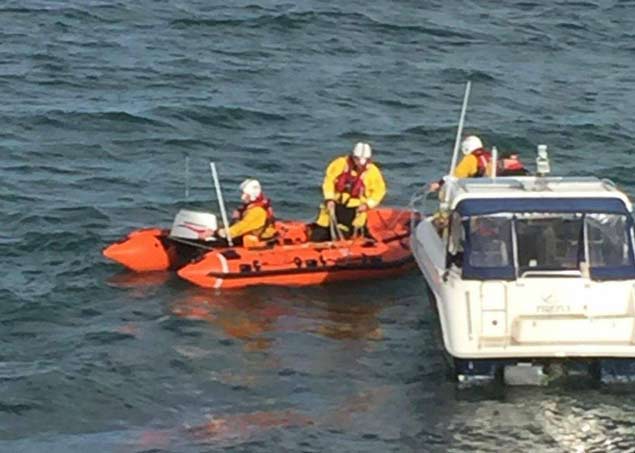 Dun Laoghaire RNLI rescue the broken down motorboat. Photo: RNLI Dun Laoghaire/Facebook
Dun Laoghaire RNLI rescue the broken down motorboat. Photo: RNLI Dun Laoghaire/Facebook
The call-out was the second service today for the inshore lifeboat. Earlier, two people on their 22–foot motorboat that had lost engine power and was at risk of grounding on rocks at the West Pier in Dun Laoghaire were brought to safety just after midday.
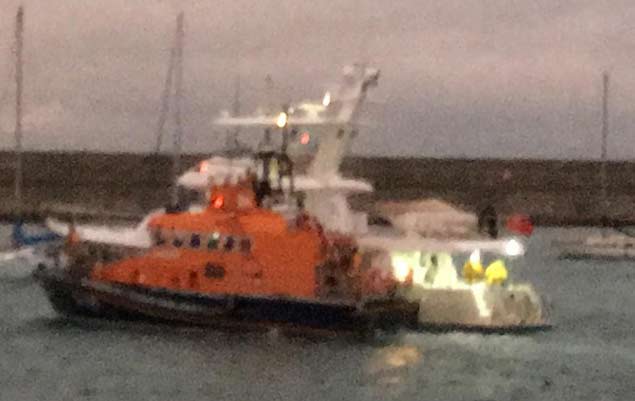 Dun Laoghaire RNLI escort the broken down motorboat safely into harbour. Photo: RNLI Dun Laoghaire/Facebook
Dun Laoghaire RNLI escort the broken down motorboat safely into harbour. Photo: RNLI Dun Laoghaire/Facebook
And on Saturday night, three people on a Scottish 60-foot cruising motoryacht were brought to safety at Dun Laoghaire in near gale force winds by the All-Weather (ALB) lifeboat in a two hour operation.
Dun Laoghaire Waterfront To Host ‘Ireland’s Largest Innovation Campus’
#DLHarbour - Reservations are now being taken for co-working spaces on Dun Laoghaire’s waterfront at what’s being touted as ‘Ireland’s largest innovation campus’.
As many as 1,000 workers will benefit from the facilities at the Harbour Innovation Campus at St Michael’s Pier, which is set to open in July next year.
Full time members can reserve a dedicated desk from €250 a month (€300 per member for a team space) with benefits including secure lockers, conference rooms and super-fast WiFi, as well as access to on-site mentors, start-up incubation, R&D labs, maker spaces and more.
More information is available in the campus’ online prospectus HERE.
Previously the former Stena HSS ferry terminal at St Michael’s Pier was made available to rent, following a partnership between the harbour company and online space-letting platform Fillit.
More recently, a “cluster of floating affordable homes” has been mooted for the adjacent Coal Harbour Dock, as reported last month on Afloat.ie.
Coastguard Medevac Alerts In West Cork & Dublin
#Coastguard - Castletownbere’s Irish Coast Guard team was alerted on Friday night (29 September) by Valentia Coast Guard to a medevac scheduled for the early hours of Saturday.
FV Argeles, a French fishing vessel, had an injured crewman onboard and was expected in Castletownbere some hours later.
The coastguard crew and Castletownbere HSE ambulance were waiting for the trawler when it docked at 2.40am. The two crews worked together to assess and stabilise the casualty, who had sustained back injuries after a fall.
After the casualty had been transferred to the ambulance, they were taken to Cork University Hospital for further treatment. The coastguard team were stood down at 5.10am.
Elsewhere, the Marine Rescue Coordination Centre in Dublin received a request for assistance from a yacht off the coast of Malahide on Thursday afternoon (28 September).
A crew member aboard the yacht, which was en route to Dun Laoghaire Marina, was ill and required medical attention.
It was agreed that the yacht would continue to its destination. RNLI Dun Laoghaire was sent to provide an escort and also dropped crew aboard to assist.
On arrival to the marina, Dún Laoghaire Coast Guard members greeted the yacht alongside HSE paramedics and gardaí. The ill crew member was transported to hospital for further medical attention.
Dun Laoghaire Seeks Interest For ‘Floating Homes’ Proposal
#Property - Plans for “a cluster of floating affordable homes” in Dun Laoghaire could soon transform the look of the South Dublin port’s waterfront.
The Dun Laoghaire Harbour Company is seeking expressions of interest via the State’s eTenders website for the development of as many as 50 single-storey homes, which would float on a pontoon on the western side of the Coal Harbour Dock.
According to The Irish Times, harbour company CEO Gerry Dunne says the floating homes — around the size of the average two-bed apartment — would have a capital cost of between €250,000 and €300,000 and would be geared towards those looking for a “starter or retirement” home.
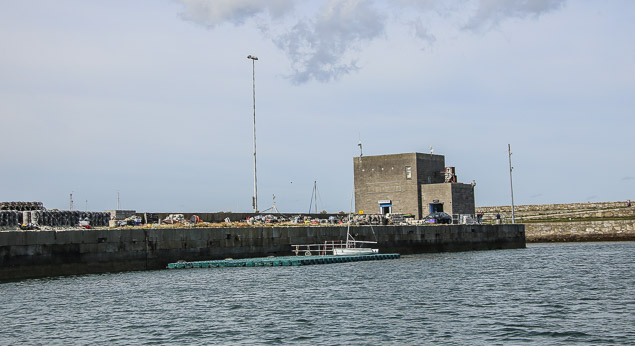 The site identified for the new floating homes in Dun Laoghaire Harbour known locally as the 'ice house' at the Coal Quays Photo: Afloat.ie
The site identified for the new floating homes in Dun Laoghaire Harbour known locally as the 'ice house' at the Coal Quays Photo: Afloat.ie
Floating accomodation is already in use by businesses in the capital, such as at Grand Canal Dock, but this is the first proposal for such a residential development in Ireland.
The Irish Times as more on the story HERE.






























